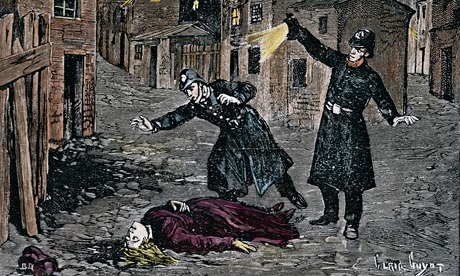This article by Notches editor Julia Laite appeared in the September 9, 2014 issue of The Guardian.
The latest development in a near-150-year-old saga made headlines this week: an armchair detective has used DNA evidence to claim that Aaron Kosminski was Jack the Ripper, the infamous figure who murdered and mutilated women in the East End of London in 1888. A Polish Jew who worked as a barber in the area, Kominski was one of the Met’s suspects at the time, though he was never charged.
Of all the fascinating mysteries and unknowns of history, why does Jack the Ripper generate so much popular interest? Part of the obsession must stem from the gruesome and sexualised nature of the killings: the Whitechapel murderer eviscerated his victims, removing parts of their organs, especially their uteruses and vaginas. The fact that several of his victims sold sex adds to the fascination. They were the fallen women, unfortunates who wandered London’s gaslit streets, who feature, caricatured and stereotyped, in so many historical and fictional accounts.
Read more | “No ‘solving’ of the Jack the Ripper case will satisfy our obsession | Julia Laite | The Guardian
 Julia Laite is a lecturer in modern British and gender history at Birkbeck, University of London. She is interested in the history of women, gender, sexuality, crime, migration, prostitution, and occasionally lorries. Her first book, Common Prostitutes and Ordinary Citizens: Commercial Sex in London, 1885-1960 was published with Palgrave Macmillan in 2011. She is currently working on trafficking and women’s migration in the early twentieth century world.
Julia Laite is a lecturer in modern British and gender history at Birkbeck, University of London. She is interested in the history of women, gender, sexuality, crime, migration, prostitution, and occasionally lorries. Her first book, Common Prostitutes and Ordinary Citizens: Commercial Sex in London, 1885-1960 was published with Palgrave Macmillan in 2011. She is currently working on trafficking and women’s migration in the early twentieth century world.

NOTCHES: (re)marks on the history of sexuality is licensed under a Creative Commons Attribution-NonCommercial-NoDerivatives 4.0 International License.
Based on a work at www.notchesblog.com.
For permission to publish any NOTCHES post in whole or in part please contact the editors at NotchesBlog@gmail.com





